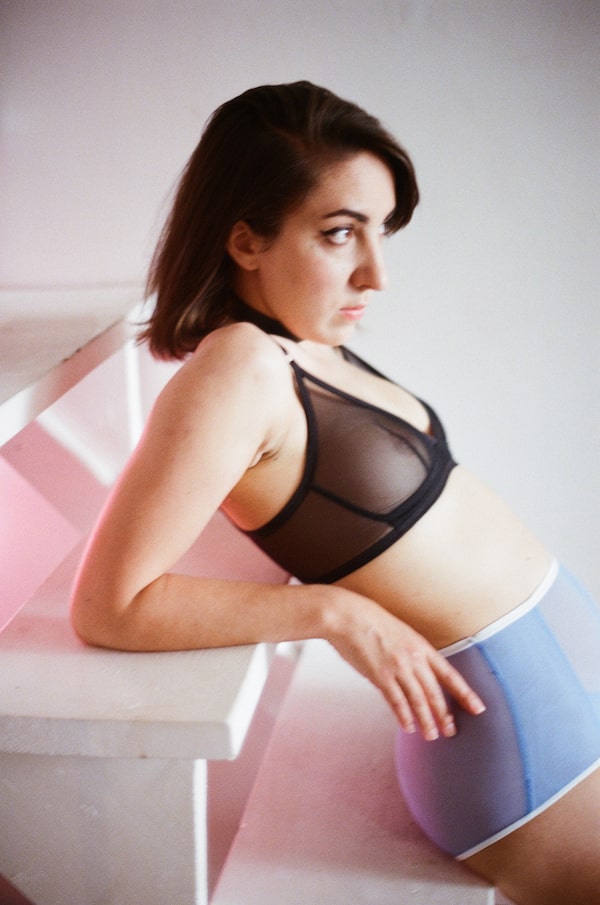
Canadian-made Bullyboy lingerie is trying to subvert the conventions of lingerie marketing.Carine Zahner/Bullyboy Lingerie
“Women should be wearing lingerie for their damn selves,” Rihanna told Vogue when she launched her Savage x Fenty lingerie brand in the spring. Accordingly, the label’s 17-minute romp at New York Fashion Week in September was set up as a series of interactive installations – more like performance art than a runway. It celebrated a diverse mix of models with many body shapes and sizes, including two visibly pregnant models. Women cavorted and posed in the lingerie, presenting the pieces as something to empower women.
The show is part of the movement that has slowly been unfolding over the last half of the decade, one that’s putting the focus of the lingerie industry on the wearer and her point of view.
Vanessa Warrack, designer of the Canadian handmade lingerie collection Bully Boy, is also intent on subverting the cultural, sexual and social conventions of lingerie marketing. Her company’s latest artistic campaign explores the role of the seen and the unseen and challenges the muse and maestro relationship – the historic idea of masculine creative genius and passive feminine muse.
Warrack commissioned the new short films from filmmaker Nadia Litz, and the five Canadian women who star in the ads are all creators themselves, from comics artist Misbah Ahmed to singer-songwriter Ralph. All were chosen, according to Litz, “because the idea of casting female creators as ‘my muses’ meant that we were already trying to rearticulate the status quo.”

Bullyboy's artistic campaign challenges the muse and maestro relationship – the historic idea of masculine creative genius and passive feminine muse.Carine Zahner
Contrast that with the model lineup revealed for the upcoming Victoria’s Secret Fashion Show, later this fall, all archetypes of tall, thin and leggy coquettes who work a slick, snappy strut. It’s increasingly out of sync with both the prevailing cultural mood and other marketing campaigns around diversity and female empowerment, and consumers have noticed. It’s no secret that the retailer has been losing ground in sales in the past year, and ratings of 2017′s televised catwalk extravaganza were down 30 per cent from the previous year to fewer than five million viewers. The lingerie giant’s narrow vision of sensuality, which has historically focused on what men find sexy, is clearly in need of a change.
It’s the last bastion in a tradition long overdue for disruption – if the corset was a long-time instrument of women’s oppression, so was the industry’s advertising. In her book on the cultural history of the corset, for example, Valerie Steele, director of the Museum at the Fashion Institute of Technology, considers advertisements from the 19th century in which the images are “almost certainly directed at a masculine gaze.” An 1880s corset advertising image by Landauer Brothers of New York, for example, depicts a woman in her boudoir putting on her lingerie and comes with instructions on how to fold it for best viewing, making it an erotic Victorian-era trading card for men. And even in cases where advertising images presume a female viewer, Steele says the subject has still “internalized the vision of herself as a spectacle for others’ eyes.”
When lingerie imagery wasn’t about erotic entertainment, it was about conforming to the dictates of style (as shaped by men). “Without foundations, there can be no fashion,” is how Christian Dior put it a century later. The designer had a vested interest: He had a side business selling women the undergarments designed to suit and support his radical new silhouettes that required modifying underpinnings (what a 1947 Life magazine called “waist-pinchers”) to flatten the abdomen and cinch the silhouette.
Diversity, inclusiveness and female empowerment aren’t limited to the marketing imagery; it’s also about the assortment of items on offer. Comfort is key in brands that directly counter the body insecurity of push-up bras and Spanx by touting that they don’t compress or reshape. Intimates brand ThirdLove tackles diversity not only in breast size but breast shape – with algorithms to help women find the perfect bra fit. Size inclusivity is a key message for brands, such as the Nude Label and Toronto-based Fortnight. What’s sexy now is body positivity.
And positivity is more important than ever with lingerie sales on the rise. According to a recent Zion Market Research report, the global lingerie market will reach US$60-billion by 2024. In Canada, sales of women’s lingerie are also increasing, last year hitting an estimated $2-billion.
“Lingerie is an opportunity for the seduction of self,” Dita von Teese declares in her foreword to In Intimate Detail, Cora Harrington’s guide for how to choose, wear and love lingerie. The new book includes chapters on each component – bras, underwear, hosiery – demystifying each piece, from explaining seams and sizing methods to care and storage.
She likens underwear to a powerful secret identity. “Unlike all the other things you may need to wear to make others happy, lingerie can truly be about dressing for yourself,” she writes. “It is a signal that you love yourself enough to take out the good stuff and feel special even on the most mundane of days.”
This reckoning with representation and inclusion not only challenges the cycle of product and marketing that’s been built on the priorities of the male gaze, it takes it out of the picture. What’s left is for and by the women who wear it.
Visit tgam.ca/newsletters to sign up for the Globe Style e-newsletter, your weekly digital guide to the players and trends influencing fashion, design and entertaining, plus shopping tips and inspiration for living well. And follow Globe Style on Instagram @globestyle.